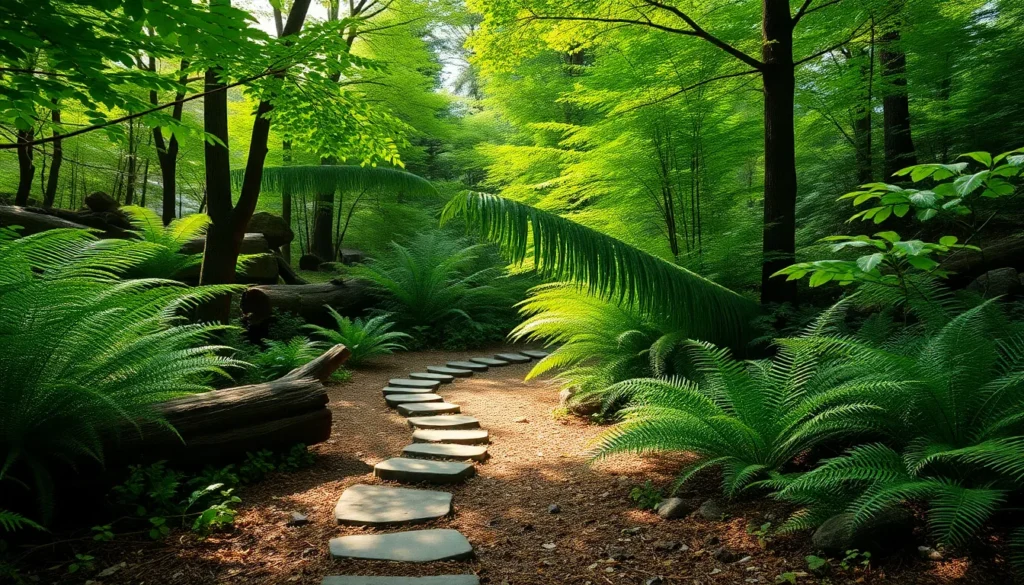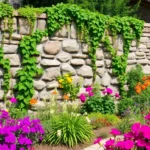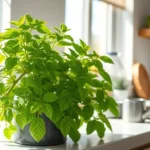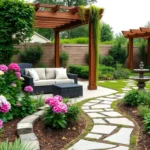We’ve all dreamed of creating that perfect garden oasis where lush greenery transforms our outdoor space into a tranquil retreat. Ferns offer an incredible opportunity to achieve this vision with their delicate fronds and timeless elegance that brings natural beauty to any industry.
Whether you’re working with a shady corner that’s been challenging to plant or you want to create a stunning focal point that’ll make your neighbors envious, fern gardens deliver impressive results with surprisingly little maintenance. These ancient plants thrive in conditions where other plants struggle and they’re perfect for gardeners who want maximum impact without constant upkeep.
From dramatic tree ferns that create living sculptures to delicate maidenhair varieties that add ethereal charm, we’ll explore creative ways to incorporate these versatile plants into your garden design. You’ll discover how to combine different fern species for texture and height while creating the perfect growing conditions that’ll keep your fern garden thriving year after year.
Create a Shaded Woodland Fern Garden
Designing a shaded woodland fern garden transforms forgotten corners into enchanting forest sanctuaries. We’ll explore how native varieties and natural elements create authentic woodland environments that thrive with minimal intervention.
Choose Native Fern Varieties for Your Region
Selecting indigenous fern species ensures your woodland garden flourishes without excessive maintenance. Native ferns adapt naturally to local soil conditions, rainfall patterns, and temperature fluctuations throughout the seasons.
Eastern regions benefit from Christmas ferns (Polystichum acrostichoides) and royal ferns (Osmunda regalis), which create dramatic backdrops against tree trunks. These hardy varieties withstand harsh winters while maintaining their architectural presence.
Western gardeners should consider sword ferns (Polystichum munitum) and lady ferns (Athyrium filix-femina) for their exceptional drought tolerance. Both species establish robust colonies that fill woodland spaces with cascading fronds.
Southern zones support sensitive ferns (Onoclea sensibilis) and cinnamon ferns (Osmundastrum cinnamomeum), which thrive in humid conditions. These moisture-loving varieties create lush understory displays beneath mature canopies.
Design Natural Pathways Through the Fern Display
Creating meandering pathways enhances the woodland experience while protecting delicate fern colonies from foot traffic. Curved routes mimic natural forest trails and encourage visitors to explore different garden perspectives.
Bark chip paths blend seamlessly with woodland aesthetics while providing soft walking surfaces. We recommend applying 2-3 inches of aged bark mulch to suppress weeds and retain soil moisture around pathway edges.
Stepping stone routes offer intimate access points through dense fern plantings. Natural flagstone or weathered concrete pavers create stable footing while allowing ferns to grow between gaps.
Pine needle trails provide authentic forest floor textures that complement native plantings. Collected pine needles create acidic conditions that many woodland ferns prefer while maintaining natural drainage patterns.
Incorporate Fallen Logs and Natural Elements
Integrating weathered logs and natural debris creates authentic woodland microhabitats that support diverse fern communities. Decaying wood provides essential nutrients while creating varied elevation levels throughout the garden.
Fallen trunk placements serve as natural raised beds for epiphytic ferns and moss communities. Position logs at different angles to create visual interest while providing seating areas for garden contemplation.
Rock groupings establish cool, moist microclimates that woodland ferns require for optimal growth. Arrange sandstone or limestone boulders to create natural windbreaks and water collection points.
Decomposing leaf litter enriches soil composition while maintaining consistent moisture levels around fern roots. Allow fallen leaves to accumulate naturally, creating the organic layer essential for woodland network health.
Design a Japanese-Inspired Fern Garden

Creating a tranquil Japanese fern garden transforms your outdoor space into a peaceful sanctuary that celebrates nature’s harmony. We’ll explore how to blend architectural fern species with traditional elements to achieve this serene aesthetic.
Select Architectural Fern Species for Structure
Tree ferns create the dramatic backbone of your Japanese-inspired design with their towering presence and tropical appeal. These magnificent specimens serve as natural sculptures that anchor the entire garden composition. Autumn ferns bring vibrant orange-red foliage that changes with the seasons, providing the ever-changing color variations essential to Japanese garden philosophy. Their seasonal transformation mirrors the Japanese appreciation for nature’s constant evolution.
Ostrich ferns develop tall, feathery fronds that create lush backdrops perfect for meditation spaces. We recommend positioning these architectural beauties to frame pathways and seating areas. Their graceful, arching growth pattern naturally guides the eye through your garden while maintaining the flowing lines characteristic of Japanese design.
Add Stone Lanterns and Water Features
Stone lanterns introduce traditional Japanese elements that provide both visual interest and gentle illumination during evening meditation sessions. Position these cultural touchstones along pathways and near seating areas to create focal points that honor authentic Japanese garden traditions.
Water features enhance the serene atmosphere through the soothing sounds of moving water. Small streams can bisect your fern garden, mimicking natural landscapes found in traditional Japanese settings. We suggest incorporating tiny ponds or gentle waterfalls that reflect the surrounding fern foliage while creating peaceful soundscapes for contemplation.
Create Zen-Like Meditation Spaces
Meditation areas use natural materials like weathered wood and smooth stone to establish peaceful seating zones throughout your fern garden. These thoughtfully placed retreats provide quiet spaces for reflection while harmonizing with the surrounding plant life.
Pathways and bridges incorporate winding routes and symbolic crossings that enhance the meditation experience. Gravel walkways represent flowing water in Japanese symbolism, while wooden bridges create transition points between different garden zones. We recommend using blank space strategically to maintain harmony, following the key Japanese design principle that empty areas are just as important as planted ones.
Build a Vertical Fern Wall Garden

Vertical fern gardens maximize growing space while creating stunning living art installations that complement any Japanese-inspired or woodland design. These space-saving answers transform empty walls into lush green focal points that bring the tranquility of nature indoors or to small outdoor spaces.
Install Proper Drainage Systems
Drainage becomes critical when growing ferns vertically since gravity affects water distribution differently than in traditional ground plantings. Each planter needs drainage holes to prevent waterlogging that can quickly kill fern roots in wall-mounted systems.
Frame construction requires sturdy wooden or metal materials that support the combined weight of plants, soil, and retained moisture. Slat designs create even spacing between planters while preventing soil spillage and ensuring proper air circulation around each fern.
Position drainage holes at the bottom of each planter compartment to allow excess water to flow naturally downward. Install catch trays or gutters beneath the lowest row to collect runoff and protect walls or floors from water damage.
Choose Compact Fern Varieties for Wall Mounting
Compact fern varieties thrive in vertical systems because they require less root space and create manageable weight loads on mounting hardware. Maidenhair Fern varieties offer delicate, lacy foliage that creates beautiful texture patterns across wall surfaces.
Lady Fern selections provide reliable growth in wall-mounted conditions while maintaining attractive arching fronds that don’t become too heavy for vertical support systems. These varieties adapt well to the confined root space typical in wall planters.
Select ferns based on mature size rather than current nursery size to prevent overcrowding as plants establish. Native species often perform better in vertical systems because they’re adapted to local humidity and temperature conditions that affect wall-mounted growing environments.
Maintain Adequate Moisture Levels
Moisture management requires consistent attention in vertical fern gardens since wall-mounted systems dry out faster than ground-level plantings. Water regularly to keep soil consistently moist but never soggy, checking daily during warm weather.
Fill planters with well-draining potting mix that retains moisture while preventing root rot in confined spaces. Humidity levels above 50% promote healthy fern growth, so consider misting systems or humidity trays for indoor installations.
Temperature control becomes important since walls can create heat pockets that stress ferns beyond their preferred 60°F to 75°F range. Monitor growing conditions closely and adjust watering frequency based on seasonal temperature changes and humidity fluctuations.
Position vertical fern walls in shaded to partially shaded locations where ferns receive indirect light without harsh sun exposure that can quickly dry out wall-mounted plantings.
Establish a Fern Rock Garden
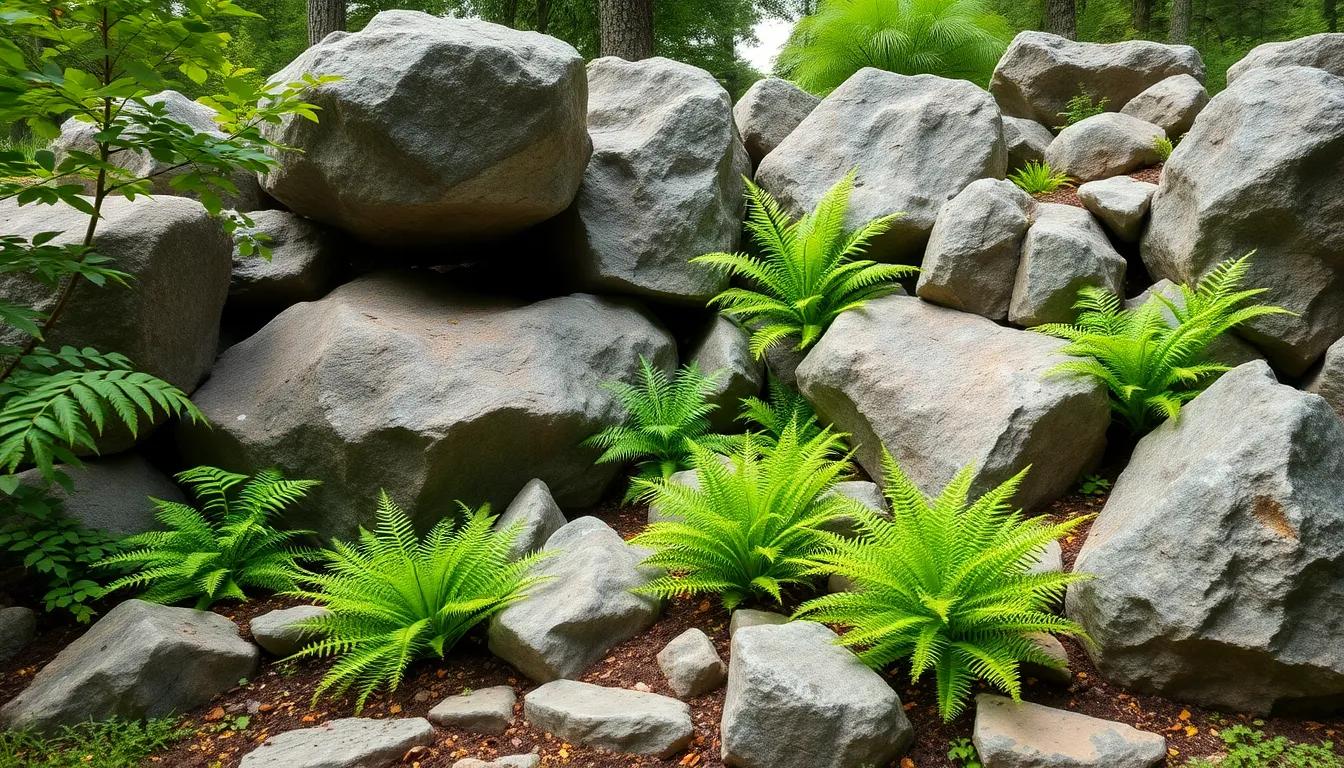
Rock gardens offer an exceptional way to showcase ferns while creating natural growing conditions that mirror their native woodland habitats. We’ll transform any space into a layered industry that provides the perfect microenvironments ferns need to thrive.
Position Rocks to Create Natural Microclimates
Strategic rock placement creates the ideal growing conditions ferns crave in our garden spaces. Large boulders and medium-sized stones cast essential shade that protects delicate fronds from harsh sunlight while maintaining the cool temperatures ferns prefer. We position these rocks at various angles to create pockets of filtered light that mimic the dappled sunshine found on forest floors.
Moisture retention becomes naturally enhanced when we arrange rocks to trap humidity and reduce evaporation around our fern plantings. Smaller stones placed at the base of larger rocks create additional microclimates by channeling water runoff and maintaining consistent soil moisture levels. We use this layered rock design to establish different zones throughout our garden where various fern species can find their preferred growing conditions.
Temperature regulation occurs naturally as rocks absorb heat during the day and release it slowly at night. We capitalize on this thermal mass effect by positioning our most temperature-sensitive ferns near larger rock formations that provide consistent environmental conditions throughout seasonal changes.
Plant Ferns in Crevices and Pockets
Crevice planting maximizes our growing space while creating stunning visual displays that appear naturally established. We select compact fern varieties like Japanese Painted Fern and Autumn Fern that adapt well to the confined spaces between rocks without overwhelming the garden design. These species provide excellent seasonal color variations while maintaining the refined appearance we want in our rock garden.
Soil preparation in rock crevices requires special attention to drainage and organic content that supports healthy root development. We fill planting pockets with a custom blend of existing garden soil mixed with organic compost to create the rich growing medium ferns need. Root establishment happens more successfully when we ensure each planting pocket has adequate depth for the exact fern variety we’re installing.
Spacing considerations become crucial when we plant multiple ferns in close proximity within our rock garden layout. We allow sufficient room for mature frond spread while creating natural groupings that enhance the overall design aesthetic. Overcrowding can lead to competition for resources and reduced air circulation that ferns need for optimal health.
Ensure Proper Soil Drainage
Drainage systems prevent the waterlogged conditions that quickly damage fern root systems in our rock garden installations. We create a foundation layer using a mixture of peat moss and perlite that maintains consistent moisture while allowing excess water to drain away efficiently. This specialized growing medium provides the perfect balance between water retention and drainage that ferns require.
Monitoring soil moisture levels helps us maintain optimal growing conditions without creating the soggy conditions that lead to root rot. We check soil dampness by gently probing the growing medium with our fingers to ensure it feels consistently moist but never waterlogged. Regular monitoring prevents both drought stress and oversaturation that can harm our fern plantings.
Watering techniques for rock gardens require more precision than traditional garden beds due to the confined growing spaces and specialized soil mixtures. We apply water slowly and evenly to allow proper absorption without washing away our custom soil blend from the rock crevices. Consistent moisture management ensures our ferns receive adequate hydration while maintaining the excellent drainage they need for long-term health.
Create a Fern Container Garden
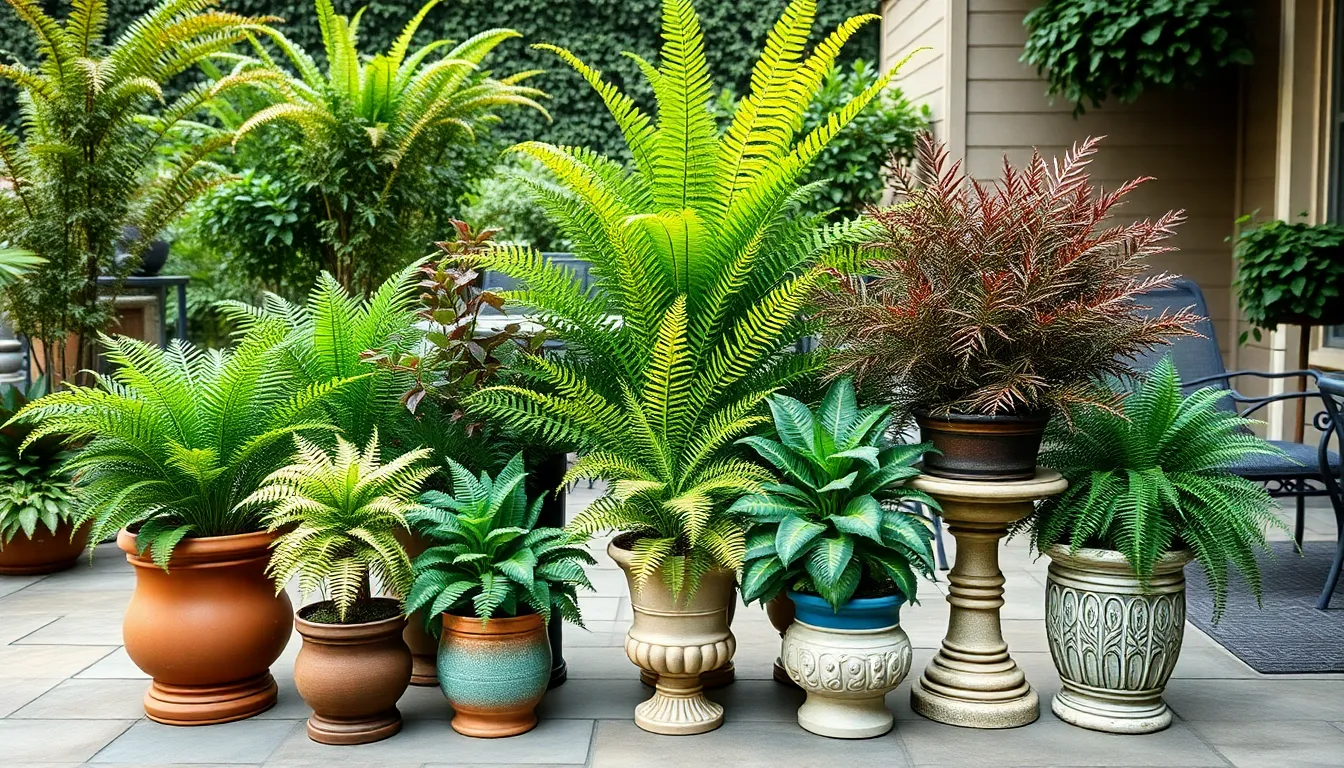
Container gardening offers us the flexibility to bring lush fern beauty to patios, balconies, and indoor spaces where traditional planting isn’t possible.
Select Appropriate Pot Sizes and Materials
Choose containers that accommodate mature fern growth by selecting pots at least 12-16 inches wide for most varieties. Large ferns like Boston and Macho varieties need containers measuring 18-24 inches across to prevent root crowding.
Prioritize materials that promote healthy air circulation such as terracotta, ceramic, or wood planters over plastic alternatives. These breathable materials help regulate soil moisture and prevent root rot by allowing excess water to evaporate through the container walls.
Ensure proper drainage by selecting pots with multiple holes at the bottom to prevent waterlogged soil conditions. We recommend placing a layer of broken pottery or gravel in the bottom before adding potting mix to enhance water flow.
Choose Fern Varieties Suitable for Containers
Boston Fern creates stunning hanging displays with its cascading green fronds that can reach 24-36 inches in length. This variety thrives in shaded locations and adapts well to container restrictions.
Macho Fern provides bold architectural presence with its broad, glossy leaves that span up to 4 feet wide in large containers. We find this variety perfect for creating dramatic focal points on patios or entryways.
Autumn Fern (Dryopteris erythrosora ‘Brilliance’) delivers year-round color interest with its striking coppery new growth that matures to deep green. This compact variety works excellently in medium-sized containers measuring 14-16 inches.
Japanese Painted Fern adds elegant contrast with its silvery green fronds and distinctive purple stems that create decorative appeal in any container arrangement. We recommend this variety for adding sophisticated color variation to fern collections.
Arrange Containers at Varying Heights
Create visual depth by positioning containers on pedestals of different heights ranging from 6 inches to 24 inches tall. This layered approach showcases each fern’s unique texture and growth pattern effectively.
Use stacked planters to maximize vertical space while creating interesting geometric patterns that draw the eye upward. We suggest combining 2-3 different sized containers in each stack for optimal visual balance.
Carry out terracing techniques on slopes or steps to create natural-looking displays that mimic woodland environments. This arrangement method highlights the varying colors and textures of different fern species at multiple viewing levels.
Develop a Fern Bog Garden
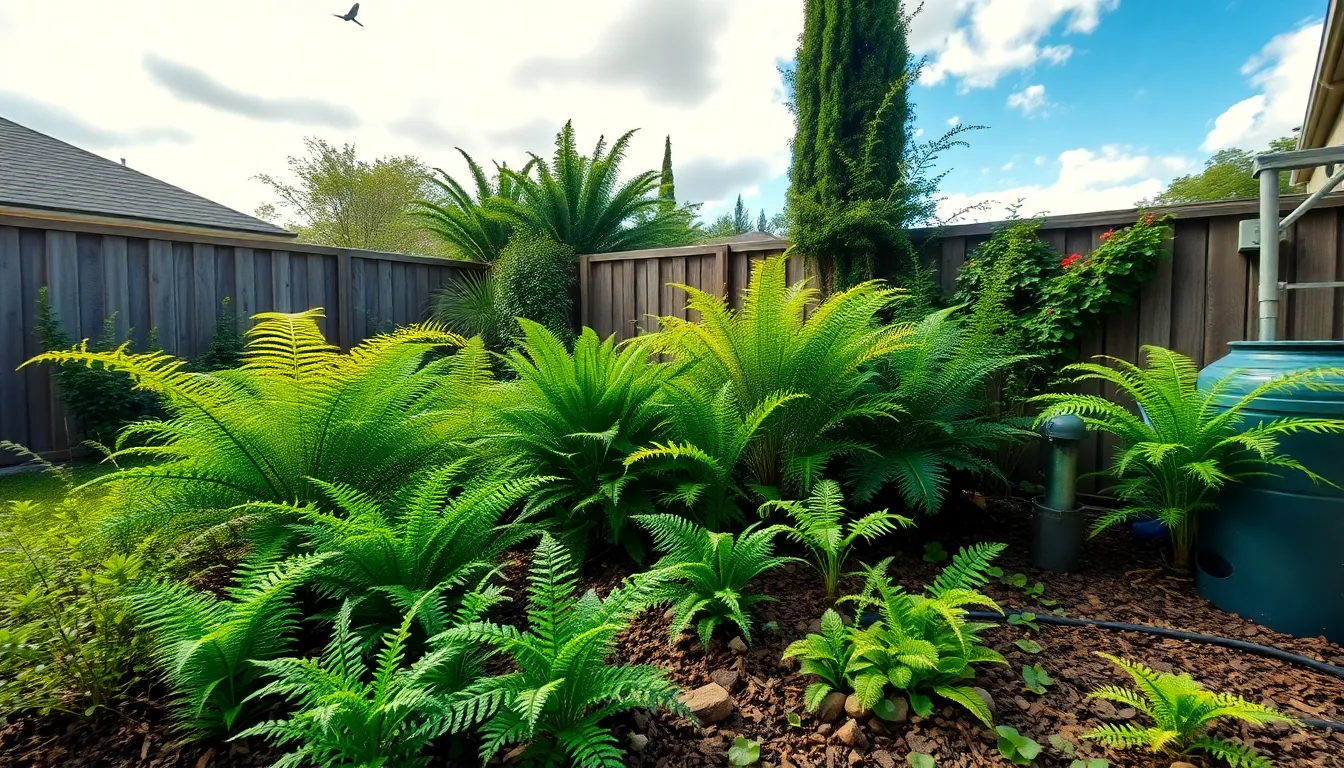
Building on our container garden foundation, we can transform any low-lying area into a thriving bog garden that mimics natural wetland environments. These specialized gardens create perfect conditions for moisture-loving ferns while adding dramatic network diversity to our industry design.
Install Proper Water Retention Systems
Mulch and compost layers form the foundation of effective water retention in bog gardens. We recommend applying 3-4 inches of organic mulch around fern plantings, using materials like shredded bark, leaf mold, or decomposed pine needles to maintain consistent soil moisture levels.
Rainwater harvesting systems ensure reliable water availability during dry periods. Installing rain barrels or underground cisterns connected to downspouts provides us with chlorine-free water that ferns prefer over treated municipal supplies.
Drainage control features prevent waterlogging while maintaining bog conditions. We create shallow depressions lined with clay or pond liner, then puncture small holes every 12 inches to allow excess water to drain slowly while retaining essential moisture.
Automatic irrigation timers maintain consistent watering schedules without daily monitoring. Drip irrigation systems or soaker hoses deliver water directly to root zones, reducing evaporation and preventing fungal diseases on fern fronds.
Choose Moisture-Loving Fern Species
Ostrich Ferns create dramatic focal points with their 4-6 foot tall shuttlecock-shaped fronds that thrive in consistently moist conditions. These native species spread naturally through underground rhizomes, forming impressive colonies over time.
Lady Ferns add delicate texture with their finely divided fronds and tolerance for both sun and shade in bog environments. We plant these versatile species in groups of 3-5 for maximum visual impact throughout the growing season.
Royal Ferns provide architectural structure with their distinctive sterile and fertile fronds that can reach 5 feet in height. These moisture-loving giants prefer acidic soil conditions and create stunning autumn displays with golden yellow foliage.
Autumn Ferns contribute year-round interest with copper-bronze new growth that matures to deep green. These evergreen species maintain their foliage through winter, providing structure when deciduous bog plants go dormant.
Maidenhair Ferns offer subtle elegance with their fan-shaped leaflets on thin black stems that dance in gentle breezes. We position these delicate species in protected areas where they receive consistent moisture without harsh wind exposure.
Create Natural Transitions to Dry Areas
Gradual moisture transitions prevent abrupt environmental changes that stress both bog and dry-loving plants. We position species with moderate water requirements like hostas and astilbe between our bog garden and traditional industry areas.
Strategic plant placement creates visual flow from wet to dry zones using plants with varying heights and textures. Taller bog species like Royal Ferns anchor the wettest areas, while medium-height transitional plants bridge the gap to lower-growing dry area specimens.
Natural pathways connect different moisture zones without disrupting water retention systems. We use stepping stones, bark chips, or pine needle paths that allow foot traffic while maintaining the bog garden’s specialized growing conditions.
Soil amendment zones provide intermediate growing conditions for plants that prefer moderate moisture levels. Mixing existing soil with compost and sand creates well-draining areas that still retain some moisture for transitional plantings.
Design a Fern Groundcover Garden
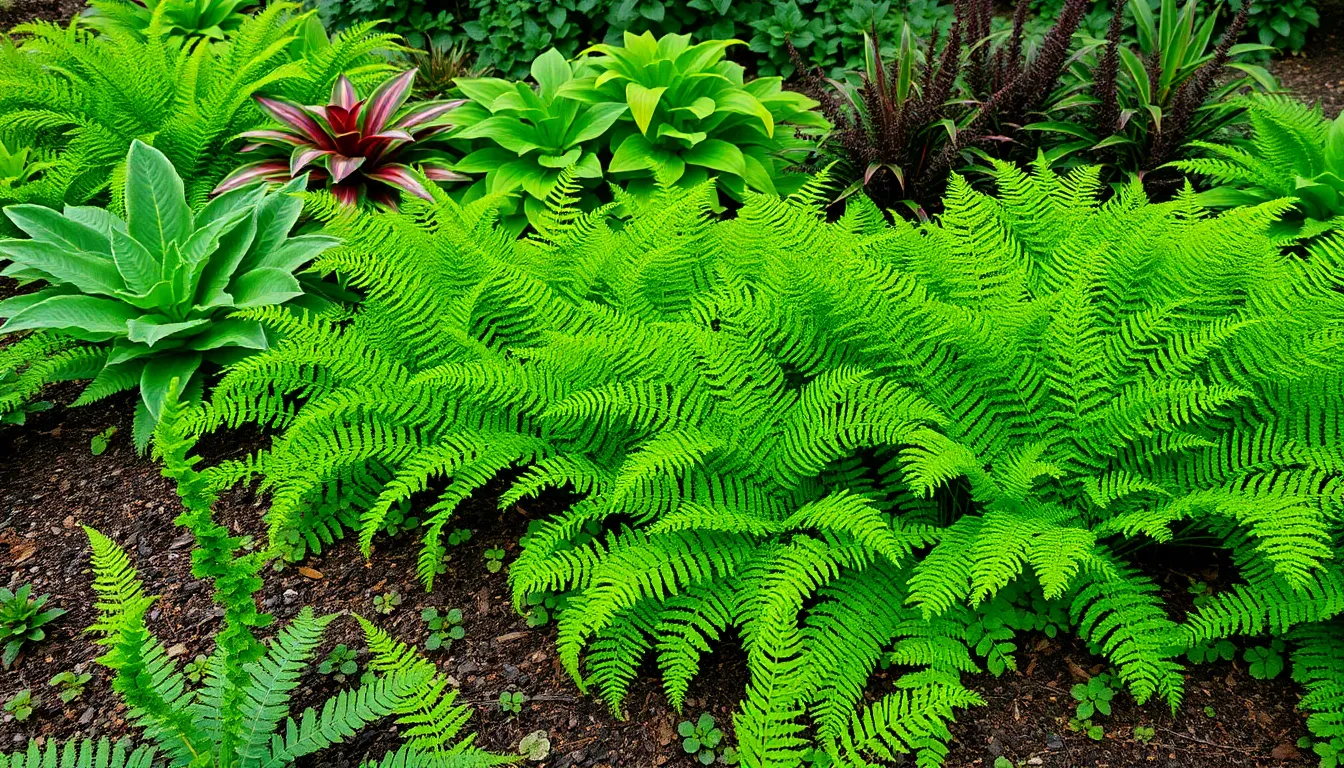
We’ll transform bare ground into lush carpets of green by selecting the right fern varieties that naturally spread and thrive in dense plantings. This approach creates sustainable, low maintenance coverage that rivals traditional groundcovers while adding unique texture and movement to our industry.
Select Low-Growing Spreading Fern Varieties
Tassel Fern becomes our go-to choice for zones 6–8, spreading effectively through underground rhizomes to create dense coverage across large areas. We’ll plant these hardy specimens 12-18 inches apart to allow natural expansion while maintaining even coverage patterns.
Lace Fern offers delicate texture for zones 10–11, providing intricate foliage patterns that create visual interest in warmer climates. This variety works particularly well in tropical and subtropical regions where we need year-round coverage.
Holly Fern thrives in zones 6–10, demonstrating robust growth patterns that establish quickly and maintain consistent coverage throughout multiple seasons. We can rely on this variety’s adaptability to varying moisture levels and light conditions.
Prepare Soil for Dense Fern Coverage
Organic matter enrichment starts with adding 2-3 inches of compost to existing soil, creating the moisture-retentive environment ferns need for dense growth. We’ll work compost into the top 6-8 inches of soil to establish proper drainage while maintaining consistent moisture.
pH adjustments require testing soil levels and amending to achieve the optimal 5.5–7 range that supports healthy fern establishment. Most ferns prefer slightly acidic conditions, so we’ll add sulfur or peat moss to lower pH when necessary.
Drainage improvements involve creating raised beds or adding organic amendments to prevent waterlogged conditions that can damage fern root systems. We’ll ensure water moves through the soil while maintaining the consistent moisture ferns require.
Plan for Seasonal Interest and Texture
Growth pattern variations combine deciduous and evergreen fern varieties to maintain visual appeal throughout all seasons. We’ll position evergreen varieties like Holly Fern as anchors while using deciduous types like Tassel Fern for seasonal color changes.
Companion plantings integrate hostas and astilbe alongside our fern groundcover to create diverse texture combinations and extend blooming periods. These shade-loving plants complement fern foliage while adding seasonal flowers and varied leaf forms.
Focal point integration incorporates eye-catching elements like Cornus Kousa dogwood or colorful fuchsia plants to break up large expanses of fern coverage. We’ll strategically place these specimens to create natural gathering points and visual anchors within our groundcover design.
Build a Fern Greenhouse Garden
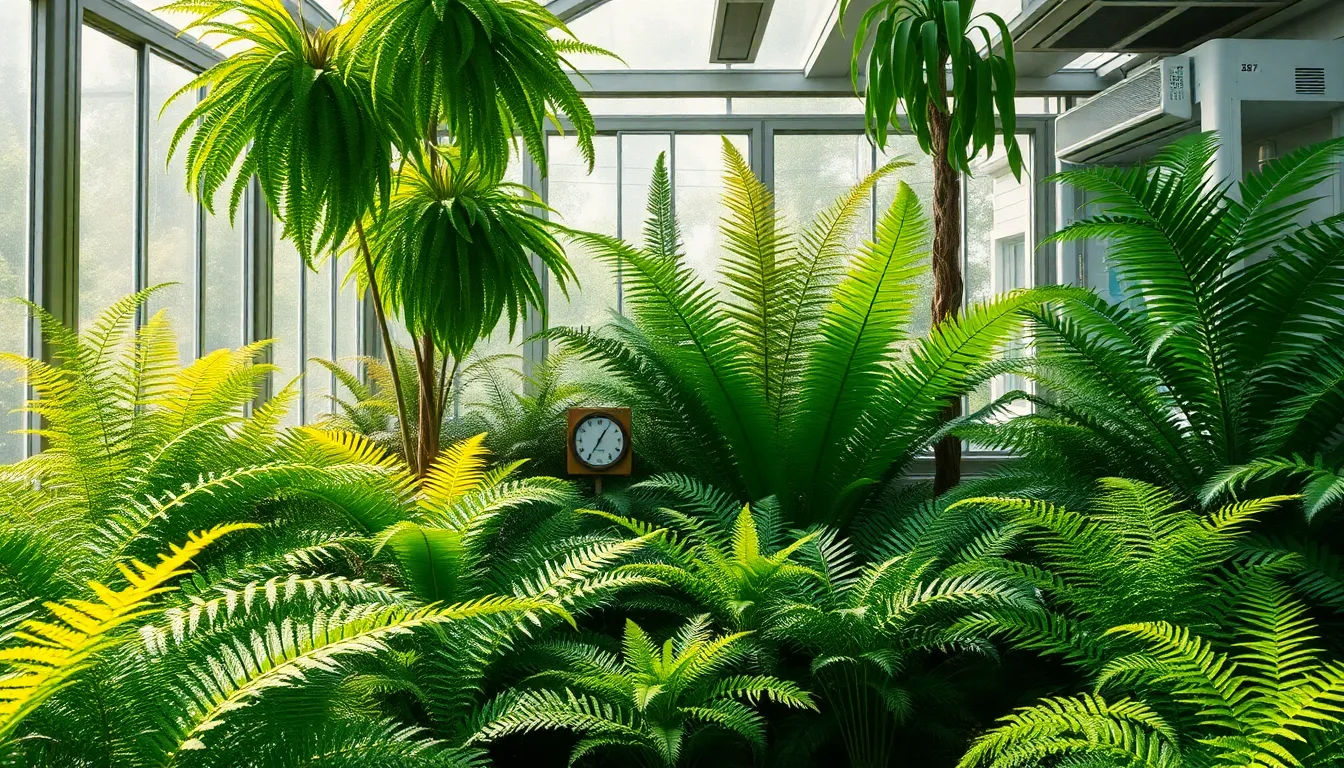
Creating a greenhouse environment opens doors to cultivating exotic fern species that wouldn’t survive outdoors in many climates. We’ll transform your greenhouse into a thriving fern paradise with precise environmental controls and careful species selection.
Control Temperature and Humidity Levels
Maintaining optimal conditions forms the foundation of successful greenhouse fern cultivation. We need to establish humidity levels between 40% to 60% for most fern species, using misting systems or humidity trays to achieve consistent moisture in the air. Temperature control requires keeping our greenhouse between 60°F to 80°F, which supports healthy growth without stressing delicate fern fronds.
Monitoring equipment becomes essential for tracking these conditions throughout the day. We can install digital hygrometers and thermometers to ensure our ferns receive stable environmental conditions. Heating mats provide gentle bottom heat during cooler months, while shade cloth reduces excessive temperature spikes in summer.
Choose Exotic and Tropical Fern Species
Selecting the right fern varieties transforms our greenhouse into a botanical showcase. Maidenhair Ferns bring delicate, fan-shaped fronds that create ethereal beauty in shaded corners of our greenhouse space. Boston Ferns offer cascading growth patterns perfect for hanging baskets, while their robust nature makes them ideal for beginners.
Lady Ferns provide elegant upright growth with finely divided fronds that add textural interest. We can incorporate these species to create layers of visual depth throughout our greenhouse environment. Tree ferns serve as dramatic focal points, reaching impressive heights and creating natural canopies for smaller species below.
Exotic varieties like Silver Lace Ferns and Japanese Painted Ferns introduce stunning foliage colors that complement traditional green species. We’ll position these specialty ferns in prominent locations where their unique characteristics shine.
Install Proper Ventilation Systems
Adequate air circulation prevents moisture buildup that can lead to fungal problems in enclosed greenhouse spaces. We need to install exhaust fans near the roof peak to allow hot, humid air to escape naturally through convection. Intake vents positioned low on opposite walls create cross-ventilation that maintains fresh air movement.
Automatic vent openers respond to temperature changes without requiring manual adjustment throughout the day. We can set these systems to activate when temperatures exceed our target range, protecting our ferns from heat stress. Circulation fans positioned strategically throughout the greenhouse ensure air movement reaches all growing areas.
Louvre vents provide precise control over airflow intensity, allowing us to fine-tune ventilation based on seasonal conditions. We’ll balance ventilation needs with humidity requirements, ensuring our ferns receive fresh air without losing essential moisture levels.
Create a Mixed Fern and Hosta Garden
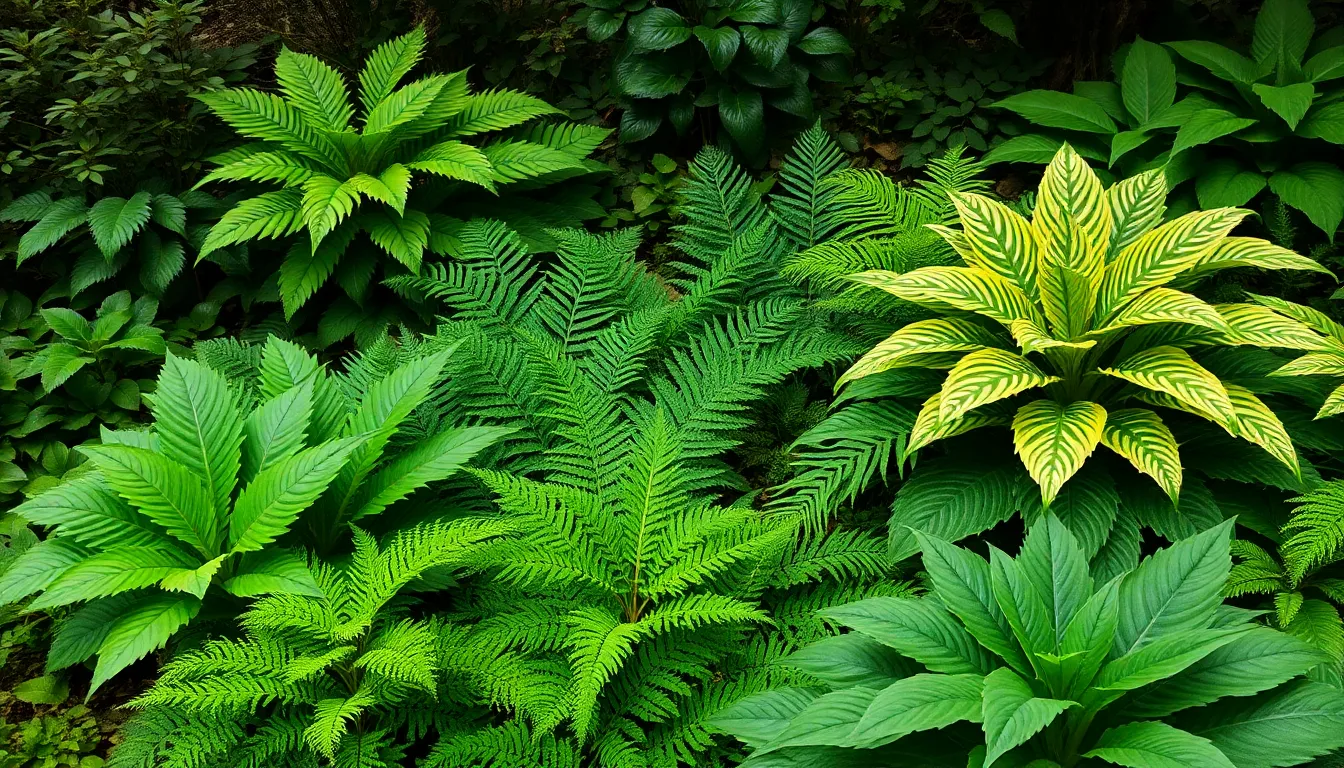
Mixed fern and hosta gardens offer stunning visual contrast while thriving in similar growing conditions. We’ll explore how these shade loving companions create ever-changing displays throughout the growing season.
Combine Complementary Textures and Colors
Fine feathery fern fronds paired with bold variegated hosta leaves create exceptional visual appeal in shaded spaces. Japanese Painted Ferns work beautifully alongside blue hostas like ‘Empress Wu’ to establish a serene woodland atmosphere that draws the eye naturally through the garden.
Texture variety becomes the foundation of successful mixed plantings when we incorporate hostas with distinctive characteristics. ‘Wiggles and Squiggles’ hostas provide rippled leaf edges that contrast beautifully with the delicate structure of surrounding ferns while adding movement to static plantings.
Height variation enhances visual interest as we layer different sized plants throughout the garden space. Companion plants at varying elevations guide the eye upward and downward creating depth and dimension that transforms ordinary shade areas into captivating garden rooms.
Color combinations reach their peak when we pair contrasting foliage tones like golden hostas with deep green ferns. Cinnamon Ferns add whimsical touches when positioned near gold hostas creating warm focal points that brighten darker garden corners.
Plan for Seasonal Growth Patterns
Sequential blooming schedules ensure continuous garden interest from spring emergence through fall dormancy. Different hosta varieties flower at staggered intervals providing extended periods of visual appeal while ferns maintain their structural presence throughout active growing months.
Compact varieties like ‘Mini Skirt’ hostas excel in container applications where space limitations require careful plant selection. These smaller specimens integrate seamlessly with similarly sized ferns creating balanced compositions suitable for patios and confined garden areas.
Year round foliage considerations become important when selecting ferns that maintain their presence through winter months. Evergreen fern species provide structural backbone while deciduous varieties offer dramatic spring emergence that complements emerging hosta shoots.
Growth timing coordination allows us to plan complementary planting schedules that maximize visual impact. Early emerging hostas pair effectively with ferns that unfurl their fronds simultaneously creating synchronized garden displays.
Ensure Compatible Growing Conditions
Shade preference alignment makes ferns and hostas natural companions for woodland and shadier garden locations. Both plant groups thrive in filtered light conditions where harsh sun would damage their delicate foliage structures.
Soil drainage requirements match perfectly as both species prefer moist but well draining conditions that prevent waterlogged root systems. Good drainage combined with consistent moisture levels creates optimal growing environments for healthy plant development.
Moisture management becomes simplified when growing these compatible species together in shared garden beds. Both plants benefit from regular watering schedules that maintain even soil moisture without creating soggy conditions that promote root rot.
Soil tolerance varies among different varieties with some hostas like ‘Formal Tuxedo’ adapting to varying soil conditions more readily than others. Understanding individual plant requirements helps us create successful mixed plantings that thrive in available growing conditions.
Establish a Fern Edging Garden
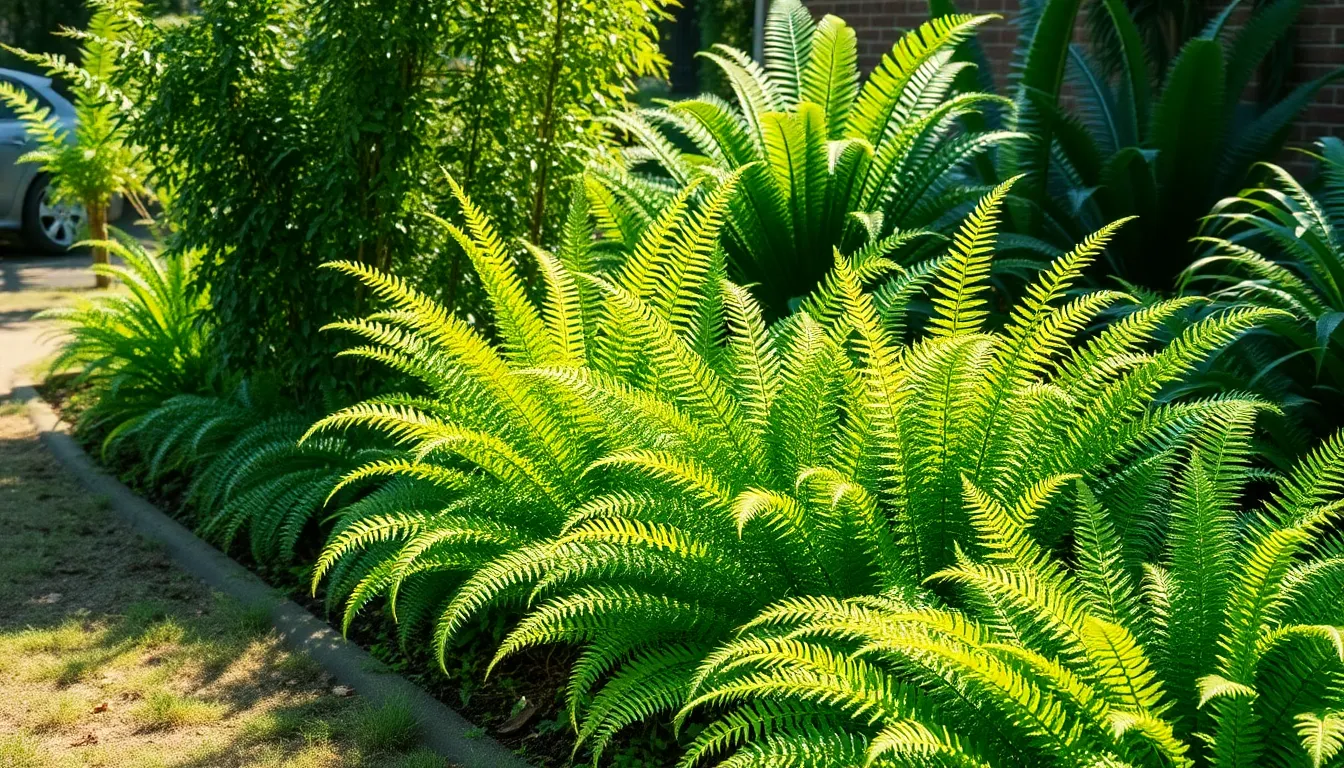
Establishing a fern edging garden creates natural borders that bring lush texture and year-round interest to garden pathways and property lines. This approach transforms ordinary garden edges into vibrant living boundaries that thrive in challenging conditions.
Use Ferns as Natural Border Plants
Ferns excel as natural border plants because they create lush barriers without the rigid appearance of traditional hedging. We can position various fern species to separate different garden areas while maintaining visual flow between spaces. Taller varieties like Ostrich Fern and Royal Fern work perfectly for creating natural screens that provide privacy without completely blocking sightlines.
Different fern species offer unique border characteristics that suit various garden needs. Lady Fern provides delicate texture for softer transitions, while Christmas Fern delivers evergreen structure throughout winter months. These natural barriers require minimal maintenance compared to traditional hedge plants, making them ideal for busy gardeners.
Strategic fern placement enhances garden definition by creating subtle boundaries that feel organic rather than forced. We recommend spacing ferns according to their mature spread to ensure proper air circulation and prevent overcrowding. This approach allows each plant to develop its full potential while maintaining the desired border effect.
Create Smooth Transitions Between Garden Areas
Layered fern plantings create seamless transitions between different garden zones by gradually changing height and texture. We achieve this by combining tall background ferns with medium-height varieties and low-growing ground cover species. This graduated approach mimics natural woodland environments where ferns create natural layers.
Mixing different fern textures adds visual interest while maintaining cohesive flow throughout the garden. Broad-leafed Royal Ferns pair beautifully with fine-textured Maidenhair Ferns, creating contrast without jarring transitions. We can enhance these combinations by incorporating ferns with different seasonal characteristics for year-round appeal.
Ground cover ferns fill gaps effectively between larger plants and create unified garden floors that connect separate areas. Tassel Fern and Holly Fern spread naturally to cover bare soil while providing consistent texture throughout the growing season. These spreading varieties eliminate the need for frequent replanting and reduce maintenance requirements.
Select Appropriate Fern Heights for Edging
Tall ferns create dramatic vertical elements that serve as living screens around garden perimeters. Ostrich Ferns can reach 3-6 feet in height, making them perfect for creating privacy barriers along property lines or hiding unsightly garden features. Royal Ferns offer similar height with broader fronds that create fuller coverage.
Medium-height ferns provide versatile edging options that work well along pathways and garden bed borders. Autumn Fern and Lady Fern typically reach 18-24 inches, offering substantial presence without overwhelming nearby plants. These varieties create gentle transitions between lawn areas and taller plantings.
Short ferns soften pathway edges and create intimate garden spaces that feel welcoming rather than imposing. Maidenhair Ferns and Cinnamon Ferns stay compact at 12-18 inches, making them ideal for narrow borders and small-scale edging applications. We recommend these shorter varieties for areas where foot traffic requires clear sightlines and easy navigation.
Conclusion
Ferns offer endless possibilities for creating beautiful sustainable gardens that thrive in challenging conditions. Whether you’re designing a woodland sanctuary, Japanese-inspired retreat, or modern vertical installation, these versatile plants adapt to virtually any garden style and space constraint.
We’ve explored how ferns excel in traditional ground plantings, container arrangements, and specialized environments like bog gardens and greenhouses. Their natural ability to create stunning visual contrasts when paired with hostas or used as elegant edging makes them invaluable design elements.
The key to success lies in understanding each fern’s exact needs and matching them to appropriate growing conditions. With proper planning and care, your fern garden will provide years of low-maintenance beauty while supporting local ecosystems and creating peaceful outdoor spaces for relaxation and contemplation.
Frequently Asked Questions
What are the main benefits of creating a fern garden?
Fern gardens offer delicate beauty with low maintenance requirements. They thrive in challenging conditions like shade and provide year-round interest. Ferns are versatile, serving as stunning focal points while creating serene, peaceful environments. They also support local ecosystems and adapt well to various garden designs from woodland settings to modern containers.
Which fern varieties are best for beginners?
For beginners, consider hardy native varieties like Christmas ferns and royal ferns in eastern regions, sword ferns and lady ferns in western areas, and sensitive ferns in southern climates. Boston ferns, autumn ferns, and Japanese painted ferns are also excellent choices due to their adaptability and forgiving nature.
How do I design a woodland fern garden?
Transform shaded areas by selecting native fern varieties suited to your region. Create natural pathways using bark chips, stepping stones, or pine needles. Incorporate fallen logs and rocks to establish diverse microhabitats. Focus on mimicking natural forest environments while ensuring proper drainage and moisture retention for optimal fern growth.
What makes a Japanese-inspired fern garden unique?
Japanese-inspired fern gardens emphasize harmony and tranquility through architectural fern species like tree ferns and autumn ferns. Incorporate traditional elements such as stone lanterns and water features. Create zen meditation spaces with winding pathways that symbolize life transitions, focusing on seasonal color variations and structural balance.
How do I create a successful vertical fern wall garden?
Build sturdy frames with proper drainage systems using materials that withstand moisture. Select compact varieties like maidenhair and lady ferns that thrive in confined spaces. Maintain consistent moisture levels and temperature control. Ensure adequate air circulation and use lightweight growing mediums suitable for vertical installations.
What’s the best approach for a fern rock garden?
Position rocks strategically to create natural microclimates that provide shade and enhance moisture retention. Use crevice planting with compact fern varieties, ensuring proper soil drainage to prevent root rot. Monitor soil moisture levels carefully and employ precise watering techniques to maintain optimal growing conditions in confined spaces.
How do I set up a fern container garden?
Choose appropriate pot sizes with excellent drainage and air circulation. Select suitable varieties like Boston fern, macho fern, or Japanese painted fern. Arrange containers at varying heights to create visual depth. Use terracing techniques to mimic natural woodland environments, ensuring proper moisture management for container-grown ferns.
What should I know about creating a fern bog garden?
Develop water retention systems using mulch layers and rainwater harvesting to maintain consistent soil moisture. Select moisture-loving species like ostrich ferns, lady ferns, and royal ferns. Create natural transitions between wet and dry areas through strategic plant placement, transforming low-lying areas into thriving wetland ecosystems.
How do I establish effective fern groundcover?
Choose low-growing spreading varieties like tassel fern, lace fern, and holly fern. Prepare soil by enriching with organic matter and improving drainage. Plan for seasonal interest by combining deciduous and evergreen ferns. Integrate companion plants and focal points while ensuring dense coverage for sustainable, low-maintenance results.
What are the requirements for a fern greenhouse garden?
Maintain 40-60% humidity levels and temperatures between 60-80°F. Install proper ventilation systems to prevent moisture buildup and ensure healthy air circulation. Select exotic tropical species like maidenhair ferns and Boston ferns. Control environmental conditions carefully to cultivate species that wouldn’t survive outdoors in your climate.
How do ferns and hostas work together in mixed gardens?
Ferns and hostas thrive in similar shade conditions and offer stunning visual contrast through fine feathery fronds paired with bold variegated leaves. Plan for seasonal growth patterns and ensure compatible soil drainage and moisture management. Create height and texture variation for depth while maintaining proper growing conditions for both plant types.
What’s the best way to use ferns for garden edging?
Select appropriate heights from tall varieties like ostrich fern to shorter options like maidenhair fern. Use strategic placement to enhance garden definition and create smooth transitions between areas. Employ layered plantings to mimic natural woodland environments, creating lush borders with year-round texture and interest along pathways and property lines.

